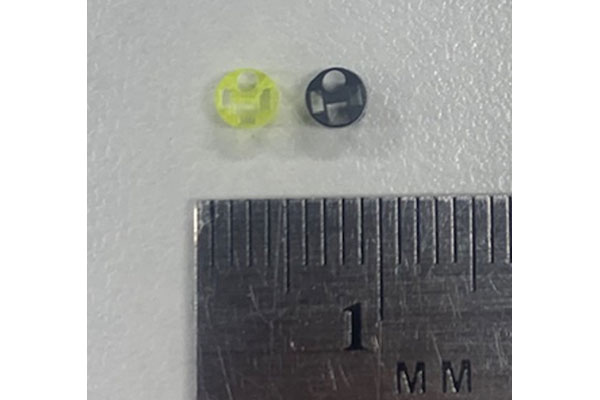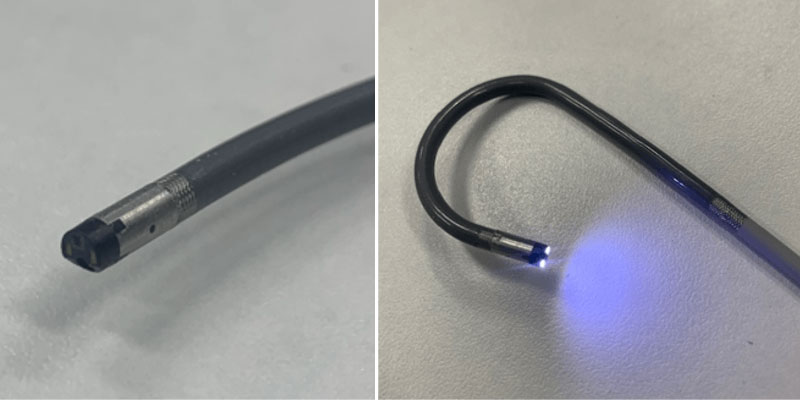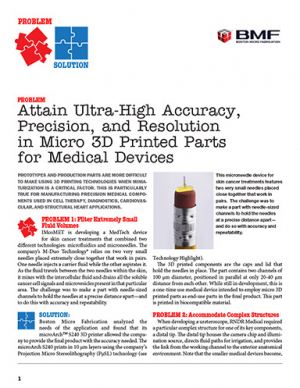Micro 3D Printing for Disposable Medical Devices
Learn how the team at RNDR Medical, a medical device design and manufacturing company used micro-precision 3D printing to fabricate a distal tip, a complex component requiring a .130” diameter profile, used within a novel single use scope for endourology.

Micro 3D printed distal tip, Micromolded distal tip.
Additive Manufacturing News
Additive Manufacturing Resources


Boston Micro Fabrication

Latest News
November 3, 2021
RNDR Medical is a team of talented and experienced medical device engineers, designers, technicians and executives focused on the advancement of medical technologies. The experts at the Louisville, Kentucky (USA) company have over 100 years of combined experience and offer a full suite of engineering services to best-in-class FDA registered clean room manufacturing.
Professional accolades include the invention of multi-million-unit product lines, over 100 patents with multiple pending, dozens of successful products launched, and bringing RNDR innovation to clinical domains ranging from endoscopy, cardiology, urology, peripheral vascular, and laparoscopy.
The Challenge
One specific product RNDR Medical developed and will soon be launching is a novel single use scope for endourology that is utilized for direct visualization and navigation to enable diagnosis and treatment of disorders in the urinary tract, such as kidney stones and urothelial carcinoma, as well as pyeloscopy procedures enabling therapeutic access to the renal pelvis and kidneys.
The ureteroscope features a digital high-definition camera and illumination that enable direct visualization of the anatomy as well as fluid irrigation for maintaining a clear image. A working channel allows passage of therapeutic tools through the ureteroscope, such as lithotripsy fibers and retrieval baskets, for the treatment of kidney stones.
A key component of this device is the distal tip, which houses the camera chip and illumination source as well as directing fluid paths for irrigation and providing the link from the working channel to the exterior anatomical environment. These elements must be contained within the distal tip with a high degree of precision while being sealed to prevent fluid ingress into the device, all within a .130” diameter profile.
Additionally, the exterior geometry of this tip component must be atraumatic to the anatomy as it is the forward facing, advancing part of the device. Containing all these design elements within such a small profile requires a component with complex 3D geometry, tight tolerances, and wall thickness traditionally only achievable through niche micro molding. Finally, mature component volumes are in the tens of thousands per year, which would result in a longer ROI for expensive micro molding.
An Alternative to Micro Molding
Anthony Appling, Principal, Co-owner and Keith Wells, Design Engineering Lead were looking for an alternative to the expense and long wait times of micro molding when they came across Boston Micro Fabrication’s Projection Micro Stereolithography (PµSL) micro 3D printing technology. Capable of achieving resolution of 2µm~25µm and tolerance of +/- 10µm~25µm, BMF’s microArch series of micro-precision 3D printers seemed to be a potential solution.
During the early phase design of the device BMF printers allowed for very quick iterative development of the distal tip component at scale. This greatly expedited the development schedule as traditional methods would have required the expense of micro machining to achieve the iterative development necessary for good design, followed by the investment and long lead time of micro molding – with potentially the need for multiple tools to properly test multiple optimal tip geometries in the correct material. The speed and flexibility of the BMF system was highly beneficial to their engineering team to hone in on an optimal design with minimal time and expense.
Further, Appling and Wells realized that the BMF material held up well to their test battery for the component such that additive manufacturing became a feasible solution not just for design development but for potential initial production volumes as well.
Appling:
“BMF 3D printing technology is critical to the fast, iterative development of precision components, enabling the advantages of additive manufacturing at-scale from prototype to production.”
Finally, the volume flexibility and manufacturing scalability of the BMF system is very attractive for product development through manufacturing. In RNDR’s case they can yield up to 500 units of tip components from a single build cycle.
In terms of measurable results, RNDR Medical credits BMF technology with cutting development time by as much as a half. BMF microscale 3D printers also enabled the company’s medical device engineers to evaluate and iterate designs in a matter of days and weeks vs months.
The geometric accuracy and material integrity of these 3D printed parts inspired confidence, and the 3D printed distal tips withstood pre-clinical evaluation in a simulated use environment.

The Future
As the company looks ahead, it’s envisioning using micro 3D printing as a bridge technology for initial commercialization and large-scale production. To determine suitability, an evaluation of available 3D materials will be especially important. At a time when demand for minimally invasive medicine is growing, there is also a need for highly functioning disposable catheters and scopes with feature-rich characteristics at the end of smaller-diameter catheters. As with the examples described in this case study show, multiple design features will need to be contained within smaller profiles.
For medical device engineers, the challenge of packing more features into less space can quickly exceed the limits of multi-axis machining and molding, where draft and uniform wall thickness must be maintained.
With microscale 3D printing, however, engineers can maximize the entire volume of a component for functionality without traditional concerns about design for manufacturing (DFM). As RNDR Medical can attest, BMF 3D printers are well-suited for visualization systems, therapy and diagnostic catheters, and delivery systems across medical device markets.
To learn more about microscale 3D printing, contact BMF. If you are a medical device manufacturer looking for an experienced innovative team that offers a full suite of engineering services, contact RNDR Medical.
More Boston Micro Fabrication Coverage

Subscribe to our FREE magazine, FREE email newsletters or both!
Latest News




